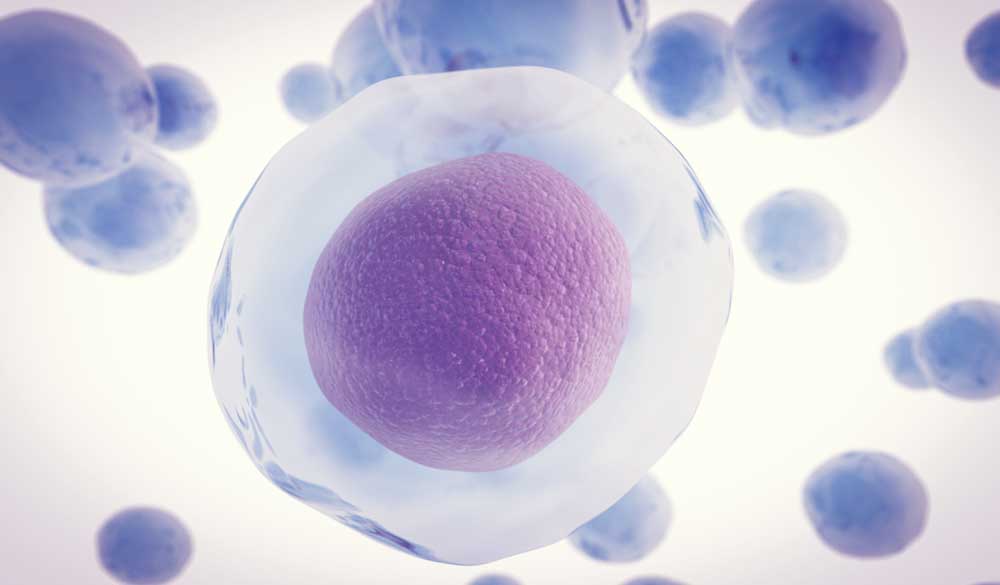Identified more than 20 years ago, and the subject of over 5500 published papers, Nrf2, or nuclear factor (erythroid-derived 2)-like 2, is a very important redox-sensitive transcription factor in all mammals.[1] It has been referred to as the activator of cellular defence, the master antioxidant switch and the guardian and gatekeeper for health and longevity.[1]
Activation of Nrf2 creates a downstream production of proteins and antioxidant enzymes, which provide benefits beyond direct-acting antioxidants.
Antioxidant supplements have a direct action on the oxidative effect of free radicals, such as reactive oxygen species (ROS) and reactive nitrogen species (RNS). However, with the discovery of Nrf2 and its signalling pathway, it is now possible to indirectly enhance cellular defence systems.[1] By regulating a large network of cell protecting (cytoprotective) genes, Nrf2 activation is critical for the body’s ability to cope with internal and external stressors, including inflammatory, oxidative and environmental.[2] It is also very important for mitochondrial homeostasis and structural integrity.[3]
Nrf2 is an intrinsic key that modulates gene expression of the cell’s primary antioxidant, detoxification and inflammatory mechanisms.[1]
The gene targets of Nrf2
Nrf2 regulates more than 600 genes. Over 100 of these are encoded for cytoprotective proteins, which increase toxin metabolism and removal, lower oxidative stress and maintain cellular homeostasis.[2,4] Nrf2 targets genes involved in:
- Glutathione synthesis and conjugation
- Antioxidant proteins and enzyme activity
- Xenobiotic metabolising enzyme and transporter activity
- Metabolism
- Transcription.[4]
Activation of Nrf2 creates a downstream production of proteins and antioxidant enzymes, which provide benefits beyond direct-acting antioxidants.
These resulting products are not fully consumed in redox reactions (unlike direct-acting antioxidants such as vitamin C) and can restore some endogenously produced antioxidants, such as CoQ10 and vitamin E, back to their reduced state. Additionally, they have a long duration of action, so they do not need to be continuously produced.[1]
Some of the most protective enzymes and proteins critical for ROS and RNS reduction, and activated by Nrf2, include:
- Catalase and superoxide-dismutase (SOD)
- GSH synthase, GSH-peroxidases and GSH-reductase
- Thioredoxin and thioredoxin reductase
- Heat shock protein 70 (HSP70)
- Haem oxygenase-1 (HO-1).[5]
The ability of Nrf2 to induce phase 2 liver enzymes also makes it a powerful detoxification agent. Prime examples are the NAD(P)H:quinone reductase (NQO1) gene, which is one of the strongest responders to chemical and genetic Nrf2 activation, and glutathione-S-transferases (GSTs). Both are required for steroid and toxin detoxification.[1,6]
Other phase 2 enzymes upregulated by Nrf2 activation are UDP-glucuronosyltransferase, N-acetyltransferases and sulphotransferases. Although most of the research has focused on phase 2, Nrf2 also affects the cytochrome P450 monooxygenase system of phase 1 liver detoxification.[5]
The downstream products of Nrf2 are often regulated through a promoter element found in many cytoprotective genes, called an Antioxidant Response Element (ARE). When combined with Nrf2 and a binding protein called Kelch-like ECH-associated protein 1 (Keap1), a cellular survival system is formed—the Keap1-Nrf2-ARE signalling pathway.[4,6]
The Keap1-Nrf2-ARE pathway
The stability, control and release of Nrf2 relies predominately on the inhibitory protein, Keap1.[7] When Nrf2 is not being used, Keap1 will bind to Nrf2 inhibiting its release and mediating proteasomal degradation.[3,5]
Keap1 is also a highly tuned sensor of a wide array of activators or inducers, especially oxidative and electrophilic stress. When inducers are present, they block the breakdown of Nrf2 and disrupt the binding interface.[3,4] This allows Nrf2 to travel to and accumulate within the cell’s nucleus.
Here it forms a complex with a small protein (Maf), binds to AREs, and initiates gene transcription.[3]
AREs, also called Electrophilic Response Elements (EpREs), play a pivotal role in cellular defence, and are found in the regulatory promoter region of hundreds of genes.[1,6] The discovery of AREs unravelled the molecular mechanisms behind Nrf2 and Keap1.[7] These promoter elements increase gene transcription, and therefore the production of the beneficial enzymes and proteins, which protect the cell from oxidative damage.[8]
The effect of Nrf2 on health and disease
Oxidative stress and inflammation contribute to a large number of chronic diseases, including atherosclerosis, inflammatory bowel disease (IBD), rheumatoid arthritis, cancer, diabetes, obesity, metabolic syndrome, and many more. Although the pathology of each of these diseases is different, Nrf2 plays a role in many of them.[6]
It is considered a major protective factor against these oxidative stress-related conditions.[9]
"Thus, Nrf2 activation or inhibition responding to cellular oxidative and electrophilic stress, and designed to restore redox homeostasis, paves a new way to understand, prevent, or even cure these complex diseases."[6]
While oxidative stress activates Nrf2, researchers have looked for other ways to induce this protein for human benefit. Interestingly, there are a large number of Nrf2 activators in foods and dietary supplements, and even in lifestyle choices.
Phytochemical activators of Nrf2
Consuming fruits and vegetables not only meets nutritional needs but also provides a rich source of antioxidants.[7] However, extensive preclinical research now demonstrates that many phytochemicals in foods and supplements also regulate Nrf2; thereby increasing intrinsic and longer-lasting antioxidant support.[8] These include:
- astaxanthin (from algae, fish and yeast)
- blueberry
- catechins (from tea, cocoa, legumes and grapes)
- coffee
- curcumin (from turmeric)
- ellagic acid (from berries, fruit and nuts)
- garlic
- ginger
- herb extracts from: milk thistle, cinnamon, rosemary, fennel, ginseng, schisandra, magnolia
- isoflavones (from legumes)
- kiwi fruit
- naringenin (from citrus)
- nutrients: vitamin D, zinc, chromium and arginine
- pomegranate
- purple sweet potato
- resveratrol (from grapes, peanuts and berries)
- sulforaphane (from cruciferous vegetables)
- whey protein.[8-15]
The most well-known and widely used nutritional Nrf2 activators are sulforaphane, resveratrol and curcumin.[8]
Sulforaphane
A powerful inducer of the Nrf2 pathway,[8] sulforaphane’s low molecular weight and lipophilic nature means it also has a high bioavailability.[1] Although it does not have a direct antioxidant effect,[1] sulforaphane specifically interacts with the Nrf2-Keap1 complex, allowing nuclear translocation and activation of ARE-responsive genes.[8] As part of this interaction with Nrf2, sulforaphane is a potent phase 2 enzyme inducer.[1]
Resveratrol
Known for its direct antioxidant effect and wide-ranging biological actions, preclinical research has also shown that resveratrol effectively activates the Nrf2/ARE complex.[8,16] Although the exact mechanism is not known, it may be by directly binding to NrF2 or Keap1.[16]
Diabetes studies demonstrate that resveratrol reduces hypoglycaemic-induced oxidative stress and renal inflammation, through its ability to improve renal expression of Nrf2/Keap1 and the downstream regulatory proteins.[10] Resveratrol also limits lipid peroxidation through this pathway, with resulting upregulation of SOD and HO-1.[16]
Curcumin
A direct and indirect antioxidant, curcumin has been shown to strongly induce phase 2 detoxification enzymes, such as HO-1, though the activation of the Nrf2-ARE pathway.
This cancer preventative measure was supported in a long-term in vivo study. It appears curcumin blocks the inhibitory Keap1 protein, while increasing Nrf2-ARE binding.[7]
"The elucidation of the mechanism by which Nrf2 acts as a cytoplasmic 'switch' to activate a battery of cytoprotective genes arguably heralds a new paradigm in nutrition science."[1]
Other healthy activators of Nrf2
The process by which the body responds to sub-lethal stress levels is called hormesis.
This is a concept that proposes low pro-oxidant levels of stress are healthy and can prolong longevity. Moderate exercise, calorie restriction and pro-oxidant exposure are all hormetic stressors.[5] It appears that Nrf2 also follows a hormetic rule, being activated by mild pro-oxidant signals and inhibited by large oxidative assaults.[1]
Moderate exercise and calorie restriction may therefore be valuable health promoting activities. Any exercise increases glucose and oxygen transport through the mitochondria with a resulting increase in ROS. In moderate exercise, a low pro-oxidant effect is created, which induces mitochondrial biogenesis and increased SOD and HO-1 expression.[5] Research indicates that Nrf2 signalling and activity are impaired by age, which may contribute to increased age-related disease risk in the elderly. Fortunately, preclinical trials show that this decline can be reduced with moderate exercise.[6] Additionally, calorie restriction has been linked to slowing of the metabolism, reducing ROS and decreasing the development of ROS-related disease.[5]
Adequate dietary protein is also important for Nrf2 activation. One property shared by all inducers is their ability to react with sulphur groups; therefore, sulphur amino acids from protein rich foods are necessary for the
Keap1-Nrf2-ARE pathway to function.[1]
Overactivation of Nrf2
Research has indicated that continued and persistent activation of Nrf2 may produce a negative effect in some cancer cells.[6] However, this may only occur with high dose pharmaceutical manipulation, genetic mutations of Keap1 and Nrf2, and changes in physiology due to the cancer.[7] This activation is different from the intermittent and beneficial effects of foods, herbs, supplements and moderate exercise.[6]
Although, high-dose antioxidants may inhibit the Nrf2 pathway, evidence is still emerging. Presumably, it would depend on various factors, such as cell type, health status, dose and type of antioxidant. It is therefore recommended that low to moderate dosing is the most beneficial for Nrf2 activation, while specifically targeting disease prevention, disease recurrence prevention or slowing of disease progression in early stage illness.[6]
In conclusion, Nrf2 plays a profound role in physiological and pathological processes. A master regulator of the antioxidant response and xenobiotic disposal, it is also a modulator of inflammation, metabolic programming, cell proliferation and survival. Activation of this critical pathway is now possible with many healthy nutritional and lifestyle interventions.
References
- Houghton CA, Fassett RG, Coombes JS. Sulforaphane and other nutrigenomic Nrf2 activators: can the clinician's expectation be matched by the reality? Oxid Med Cell Longev 2016;2016:7857186. [Full text]
- Eggler AL, Savinov SN. Chemical and biological mechanisms of phytochemical activation of Nrf2 and importance in disease prevention. Recent Adv Phytochem 2013;43:121-155. [Full text]
- Dinkova-Kostova AT, Abramov AY. The emerging role of Nrf2 in mitochondrial function. Free Radic Biol Med 2015;88(Pt B):179-188. [Full text]
- Lu MC, Ji JA, Jiang ZY, et al. The Keap1-Nrf2-ARE pathway as a potential preventive and therapeutic target: an update. Med Res Rev 2016;36(5):924-963. [Abstract]
- Bocci V, Valacchi G. Nrf2 activation as target to implement therapeutic treatments. Front Chem 2015;3:4. [Full text]
- Gao B, Doan A, Hybertson BM. The clinical potential of influencing Nrf2 signaling in degenerative and immunological disorders. Clin Pharmacol 2014;6:19-34. [Full text]
- Huang Y, Li W, Su ZY, et al. The complexity of the Nrf2 pathway: beyond the antioxidant response. J Nutr Biochem 2015;26(12):1401-1413. [Full text]
- Jiménez-Osorio AS, González-Reyes S, Pedraza-Chaverri J. Natural Nrf2 activators in diabetes. Clinica Chimica Acta 2015;448:182-192. [Abstract]
- Hodges RE, Minich DM. Modulation of metabolic detoxification pathways using foods and food-derived components: a scientific review with clinical application. J Nutr Metab 2015;2015:760689. [Full text]
- Bhakkiyalakshmi E, Sireesh D, Rajaguru P, et al. The emerging role of redox-sensitive Nrf2-Keap1 pathway in diabetes. Pharmacol Res 2015;91:104-114. [Abstract]
- Dong Q, Hou H, Wu J, et al. The Nrf2-ARE pathway is associated with Schisandrin b attenuating benzo(a)pyrene-induced HTR cells damages in vitro. Environ Toxicol 2016;31(11):1439-1449. [Full text]
- Fan J, Liu D, He C, et al. Inhibiting adhesion events by Panax notoginseng saponins and Ginsenoside Rb1 protecting arteries via activation of Nrf2 and suppression of p38 - VCAM-1 signal pathway. J Ethnopharmacol 2016;192:423-430. [Abstract]
- Kerasioti E, Stagos D, Tzimi A, et al. Increase in antioxidant activity by sheep/goat whey protein through nuclear factor-like 2 (Nrf2) is cell type dependent. Food Chem Toxicol 2016;97:47-56. [Abstract]
- Sun Z, Park SY, Hwang E, et al. Dietary Foeniculum vulgare mill extract attenuated UVB irradiation-induced skin photoaging by activating of Nrf2 and inhibiting MAPK pathways. Phytomedicine 2016;23(12):1273-1284. [Abstract]
- Surai PF. Silymarin as a natural antioxidant: an overview of the current evidence and perspectives. Antioxidants (Basel) 2015;4(1):204-247. [Full text]
- Poulose SM, Thangthaeng N, Miller MG, et al. Effects of pterostilbene and resveratrol on brain and behavior. Neurochem Int 2015;89:227-233. [Abstract]
DISCLAIMER:
The information provided on FX Medicine is for educational and informational purposes only. The information provided on this site is not, nor is it intended to be, a substitute for professional advice or care. Please seek the advice of a qualified health care professional in the event something you have read here raises questions or concerns regarding your health.



